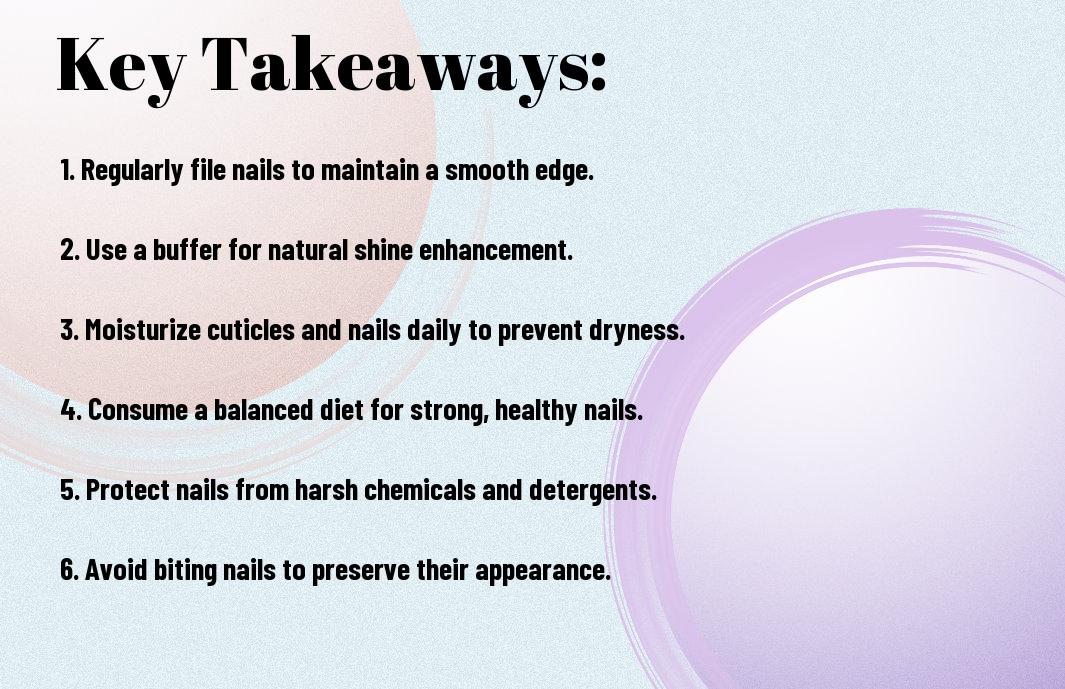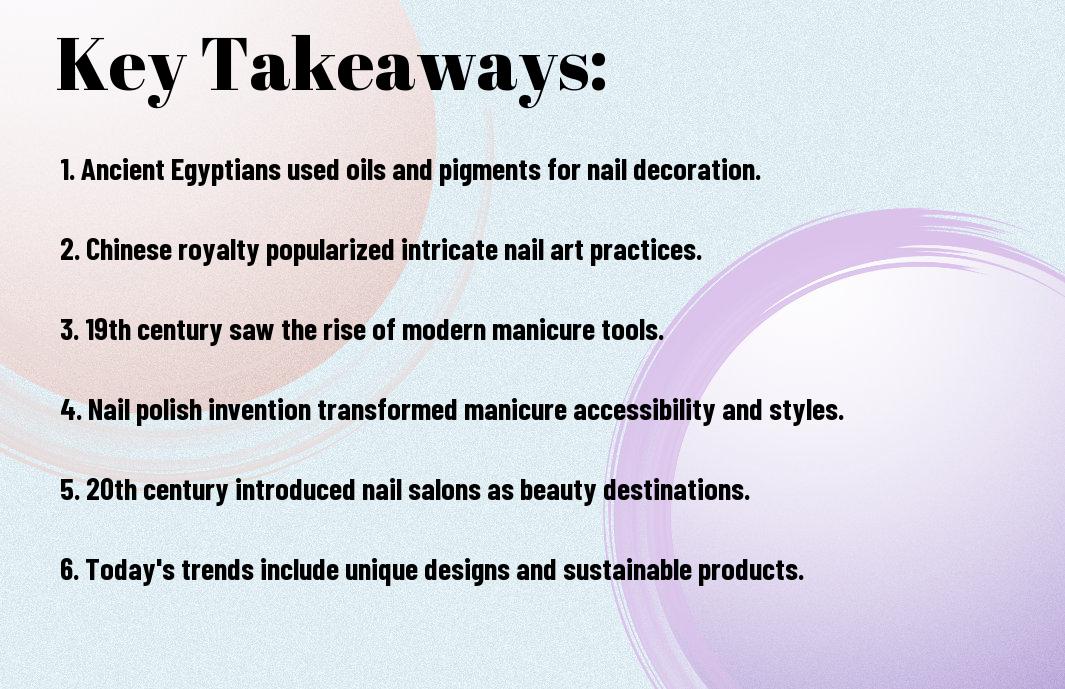Many people desire shiny, healthy nails but think polish is the only way to achieve this look. Fortunately, there are several effective methods to keep your nails looking glossy and vibrant without the use of nail polish. In this post, you’ll discover simple yet impactful tips that will enhance your nails’ natural luster while promoting their overall health. Whether you’re aiming for a clean, polished appearance or just want to embrace your natural beauty, these strategies will help you maintain beautiful nails effortlessly.
Key Takeaways:
- Hydration: Keeping your nails hydrated with natural oils, like olive or coconut oil, can enhance their shine and promote health.
- Buffing: Regularly buffing your nails can remove ridges and create a smooth surface, making them appear shinier without the need for polish.
- Diet: A balanced diet rich in vitamins and minerals, particularly biotin, can strengthen your nails and naturally improve their luster.

Understanding Nail Anatomy
Your nails are not just a fashion statement; they are complex structures that serve various functions. Knowing how your nails are built and what they’re composed of can help you care for them better. Nails consist of several components, including the nail plate, nail bed, and cuticle, each playing a vital role in overall nail health. Recognizing the anatomy of your nails allows you to address issues effectively and maintain their natural shine without relying on polish.
Structure of the Nail
Around the visible nail plate, you’ll find several important structures. The nail plate is made of keratin and forms the hard surface of your nails. Beneath it lies the nail bed, which supplies nutrients and supports growth. The cuticle protects these delicate structures from damage and infections while providing a barrier to moisture. Understanding this structure is imperative for effective nail care and maintaining their natural appearance.
Importance of Healthy Nails
Beside being aesthetically pleasing, healthy nails are vital for your overall well-being. They serve as a protective barrier for the tips of your fingers and can signal your health status. Healthy nails can also indicate good hygiene and proper nutrition, making them an imperative aspect of your personal grooming routine.
Further, maintaining healthy nails is not just about looks; it can influence your comfort and functionality. Weak or damaged nails may lead to discomfort while performing daily tasks or can become entry points for infections. By prioritizing nail health through proper care, hydration, and nutrition, you ensure not only beautiful but also strong and resilient nails that contribute to your overall confidence and well-being.
Daily Habits for Shiny Nails
Any daily habits can significantly enhance the appearance of your nails if practiced consistently. Simple actions like keeping your hands moisturized, avoiding harsh chemicals, and protecting your nails from excessive water can lead to healthier, shinier nails. Incorporate a routine that nurtures your nails and cuticles by applying a nourishing oil daily. This habit not only enhances shine but also encourages growth and strength, ensuring your nails look their best naturally.
Proper Nail Care Routine
About establishing a proper nail care routine is key to maintaining shiny, healthy nails. Start by gently filing your nails to shape them, avoiding harsh cutting to prevent splitting. Regularly clean beneath your nails and push back your cuticles to encourage growth. Finish off your routine with a moisturizing hand cream or cuticle oil, which can help maintain hydration and prevent brittleness.
Nutrition for Nail Health
Any nutrition you consume plays a vital role in your nail health. A diet rich in vitamins and minerals, particularly biotin, zinc, and protein, can promote stronger and shinier nails. Foods like nuts, eggs, fish, and leafy greens provide crucial nutrients that directly impact the health of your nails. Staying hydrated also supports your nails’ natural shine by preventing dryness and brittleness, leading to healthier overall growth.
Shiny nails often reflect a well-balanced diet. Consider adding foods high in omega-3 fatty acids, such as salmon and flaxseeds, for added nourishment. Additionally, incorporating Vitamin E rich foods, like avocados and whole grains, can help improve blood circulation to your nails, enhancing their appearance even further. Prioritize your nutrition, and you will naturally achieve the shiny nails you desire.
Natural Remedies for Shine
Not all shiny nails require polish or salon treatments. Embracing natural remedies can give your nails a beautiful sheen without the use of chemical products. Simple ingredients from your kitchen, along with some dedicated care, can enhance your nail’s natural luster. This approach not only highlights your nails but also promotes overall nail health.
Oils and Moisturizers
Before exploring into remedies, it’s necessary to hydrate your nails with oils and moisturizers. Natural oils like jojoba, coconut, and olive oil are perfect for nourishing your nails while keeping them shiny. Simply massage a few drops into your nails and cuticles daily to enhance shine and prevent dryness.
DIY Nail Treatments
Shine is not just a surface level quality; you can achieve it through simple home treatments. DIY nail treatments can involve natural ingredients that restore your nails’ initial glow. From lemon juice to vinegar, these ingredients can be mixed to create effective solutions that brighten and polish your nails without harsh chemicals.
Due to the effectiveness of these DIY treatments, you can create a simple yet potent mix at home. A blend of olive oil and lemon juice acts as a natural buffer, both adding shine and providing nourishment. For an invigorating scrub, combine sugar with coconut oil. This not only helps remove dead skin around your nails but also leaves them smoother and shinier. Regular use of these treatments can significantly enhance the natural beauty of your nails, offering longer-lasting results without the need for polish.

The Role of Hygiene
Once again, maintaining proper hygiene plays a significant role in keeping your nails shiny without the need for polish. Regularly cleaning your nails and cuticles prevents dirt and bacteria from accumulating, which can dull their appearance. Washing your hands frequently and using a gentle nail brush can help reveal the natural shine of your nails. By prioritizing hygiene, you not only improve the aesthetic appeal of your nails but also promote overall health and well-being.
Cleaning Techniques
One effective cleaning technique is to soak your nails in warm, soapy water to loosen any grime or debris. Follow this by gently scrubbing your nails with a soft-bristled brush to ensure thorough cleansing. Don’t forget to rinse well and dry your hands thoroughly, as moisture can contribute to irritations. Combining these practices helps in maintaining your nails’ natural luster without compromising your nail health.
Tools for Nail Care
Along with proper cleaning, using the right tools for nail care is imperative in achieving shiny nails. Investing in quality nail clippers, cuticle pushers, and a file will allow you to maintain your nails’ shape and length effectively. Regularly caring for your cuticles with a cuticle remover or oil also helps to promote healthy nail growth and enhances their natural shine.
Consequently, having the right tools can significantly enhance your nail care routine. Look for ergonomic nail clippers that provide a clean cut without splitting, as well as a textured file designed to smooth edges. A gentle cuticle pusher will help you maintain tidy cuticles, while a moisturizing nail cream will further nourish and hydrate your nails, preventing dryness. By using these tools consistently, you’ll see a remarkable difference in the appearance and health of your nails.
Lifestyle Choices Impacting Nail Appearance
All aspects of your lifestyle can significantly affect the appearance of your nails. From your diet to your habits, every choice you make influences how your nails look and feel. Adopting healthy practices can promote strong and shiny nails, allowing you to shine without the need for polish.
Effects of Hydration
Lifestyle factors such as hydration play a vital role in maintaining the health of your nails. When you drink enough water, your body is better able to nourish your nails from within, making them look more vibrant and resilient. Conversely, dehydration can lead to brittleness and a dull appearance.
Impact of Smoking and Alcohol
Below the surface, habits like smoking and excessive alcohol consumption can detrimentally impact your nail health. These substances can lead to discoloration, weaken nail structure, and slow down the natural growth process, making your nails appear less shiny and healthy.
To improve your nail appearance, it is important to consider how smoking and alcohol consumption deplete your body of vital nutrients. These habits can also impair circulation, which is vital for nail health, leading to slow growth and weakening of your nails. By reducing or eliminating these habits, you can enhance your overall nail health and achieve that naturally glossy look you desire.
Professional Treatments
Despite the allure of at-home remedies, professional treatments can elevate your nails to a new level of shine. Visiting a salon for specialized nail care services ensures your nails receive expert attention and high-quality products. For tips on maintaining shine, you can refer to How to prevent my nail polish from losing its shine, which highlights various techniques and treatments.
Manicures for Natural Shine
One of the most effective ways to achieve shiny nails without polish is through regular manicures. A professional manicure not only cleans and shapes your nails but also polishes them to enhance their natural gloss. The use of oils or moisturizers during the process can deeply nourish your nails, promoting a radiant finish.
Products to Consider
Shine-enhancing products specifically designed for nail care can significantly boost your nails’ appearance. Using oils, creams, or lotions formulated to nourish and hydrate will help maintain a glossy look without the need for polish.
Consider integrating oils rich in vitamin E or jojoba oil into your routine for maximum benefits. These products not only add shine but also provide important nutrients that strengthen your nails over time. Just a few drops massaged into your nails and cuticles will work wonders, giving them a healthy, polished look free from any artificial gloss.
Final Words
Hence, maintaining shiny nails without polish is entirely possible through consistent care and natural methods. You should focus on proper hydration, a balanced diet rich in vitamins, and regular nail grooming. Incorporating oils, such as olive or coconut oil, can enhance the natural luster of your nails. Moreover, using a soft buffer can polish your nails to a shine without the need for any chemical products. By following these tips, you can enjoy beautiful, healthy, and shiny nails that make a statement on their own.
FAQ
Q: How can I achieve naturally shiny nails without using polish?
A: To achieve naturally shiny nails, maintain a regular nail care routine. Start by keeping your nails clean and trimmed. Then, file them smoothly to avoid rough edges. Moisturizing your nails and cuticles with a nourishing oil or cream can also enhance their shine. Buffing your nails gently with a nail buffer will further increase their glossiness, giving them a polished look without any nail polish.
Q: What dietary changes can help improve the shine of my nails?
A: Your diet plays a significant role in the health and appearance of your nails. Incorporate foods rich in biotin, such as eggs, nuts, and seeds, as this vitamin promotes stronger and shinier nails. Omega-3 fatty acids, found in fish and flaxseeds, can also enhance moisture levels in nails, resulting in a healthier shine. Ensure you stay hydrated by drinking plenty of water, as proper hydration is vital for nail health.
Q: Are there any home remedies to naturally enhance nail shine?
A: Yes, several home remedies can help enhance the shine of your nails. One effective method is to create a mixture of olive oil and lemon juice. Combine equal parts and soak your nails in this mixture for about 10 minutes. The oil provides moisture while the lemon acts as a natural whitener and brightener. Another option is to rub a slice of cucumber on your nails, which can naturally boost their shine due to its hydrating properties.
Q: How often should I buff my nails for the best results?
A: Buffing your nails can contribute to their shine, but it’s imperative not to overdo it. Ideally, buff your nails once every two weeks to avoid thinning them. Use a gentle nail buffer and apply it lightly to smooth out any ridges and enhance the shine. Consistent buffing at this frequency can keep your nails looking healthy and radiant without damaging their surface.
Q: Can using hand lotion help maintain shiny nails?
A: Yes, using hand lotion is beneficial for maintaining shiny nails. A good hand cream hydrates not only your skin but also your nails and cuticles. Look for lotions that contain ingredients such as shea butter or vitamin E, as they provide deep moisture and nourishment. Regularly applying lotion, especially after washing your hands, can keep your nails from becoming dry and brittle, which helps preserve their shine over time.







